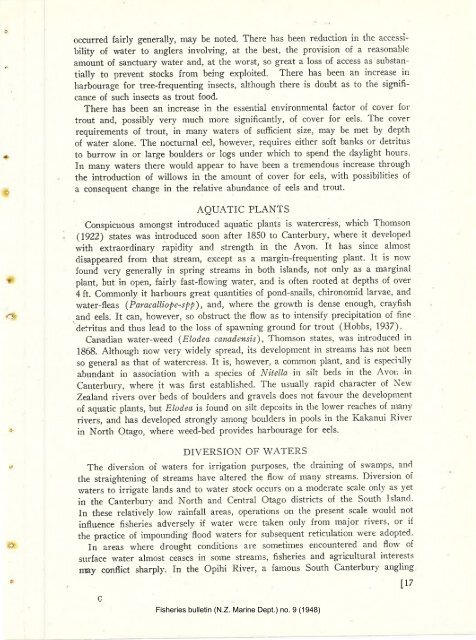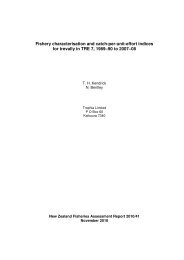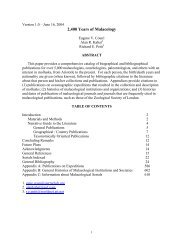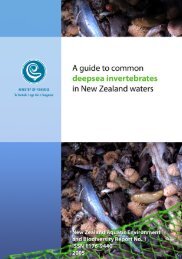N.Z. MARINE DEPARTMENT-FISHERIE,S BULLETIN No. .į
N.Z. MARINE DEPARTMENT-FISHERIE,S BULLETIN No. .į
N.Z. MARINE DEPARTMENT-FISHERIE,S BULLETIN No. .į
You also want an ePaper? Increase the reach of your titles
YUMPU automatically turns print PDFs into web optimized ePapers that Google loves.
occurred fairly generally, may be noted. There has been reduction in the accessibility<br />
of water to anglers involving, at the best, the provision of a reasonable<br />
amount of sanctuary water and, at the u'orst, so great a loss of access as sttbstantially<br />
to prevent stocks from being exploited. There has been an increase in<br />
harbourage for tree-frequenting insects, although there is doubt as to the significance<br />
of such insects as trout food.<br />
There has been an increase in the essential environmental factor of cover for<br />
trout and, possibly very much more significantly, of cover for eels. The cover<br />
requirements of trout, in many waters of suffrcient size, may be met by depth<br />
of wate¡ alone. The nocturnal eel, however, requires either soft banks or detritus<br />
to burrow in or large boulders or logs under which to spend the daylight hours.<br />
In many waters there would appear to have been a tremendous increase through<br />
the introduction of willows in the amount of cover for eels, with possibilities o{<br />
a consequent change in the relative abundance of eels and trout.<br />
AQUATIC PLANTS<br />
Conspicuous amongst introduced aquatic plants is watercréss, which Thomson<br />
(1922) states was introduced soon after 1850 to Canterbury, where it developecl<br />
with extraordinary rapidity and strength in the Avon. It has since almost<br />
clisappeared from that stfeam, except as a margin-frequenting plant. It is nou'<br />
found very generally in spring streams in both islands, not only as a marginal<br />
plant, but in open, fairly fast-flowing water, and is often rooted at depths of over<br />
4 ft. Commonly it harbours great quantities of pond-snails, chironomid larvae, and<br />
water-fleas (Poracattioþe-,sþþ), ancl, where the growth is dense enough, crayfish<br />
.and eels. It can, however, so obstruct the flow as to intensify precipitation of flne<br />
defritus and thus leacl to the loss of spawning ground for trout (Hobbs, 1937).<br />
Canadian water-weed (Elod,ea canad,ensis), Thomson states, was introducecl in<br />
1868. Although now very widely spreacl, its development in streams has not been<br />
so general as that of watercress. It is, however, a conrûlon plant, and is especirlly<br />
abundant in association with a species of Nitetta in silt beds in the Avor .ir-r<br />
Canterbury, where it was first established. The usually rapicl character ol Nerv<br />
Zealand. rivers over beds of boulders and gravels does not favour the developmer-rt<br />
of equatic plants, but Elodea is found on silt deposits in tl-re lower reaches of many<br />
rivers, ancl l-ras developed strongly among boulclers in pools in the Kakanui River<br />
in <strong>No</strong>rth Otago, where weed-bed provides harbourage for eels.<br />
DIVERSION OF WATERS<br />
The diversion of waters for irrigation purposes' the clraining of swanrps, anrl<br />
the straightening of streams have altered the flow of many streams. Diversion of<br />
.lvaters to irrigate lands and to r,vater stock occttrs on a moderate scale only as yet<br />
in the canterbur¡, ancl <strong>No</strong>rth ancl Central Otago districts of the South Islancl.<br />
In these relatively lo.¡'rainfall areas, operations on the present scale would not<br />
infltrence fisheries adversely if lvater were taken only from rnajor rivers, or if<br />
the practice of impounding floocl lr,'aters for subsequent reticulation were adopted.<br />
In areas where drought conclitions are sometimes encountered ancl flolr'' of<br />
surface water almost ceases in sorne streams, fisheries and agricultural interests<br />
rnay conflict sharply. In the Opihi River, a farnous South Canterbury angling<br />
Ç<br />
Fisheries bulletin (N.Z. Marine Dept.) no. 9 (1948)<br />
lr7







